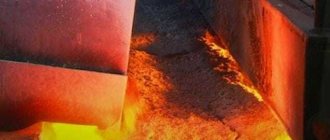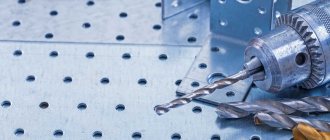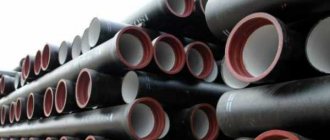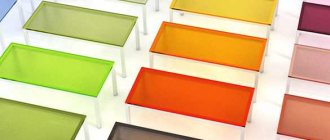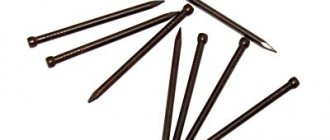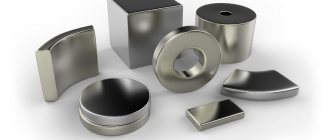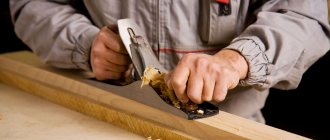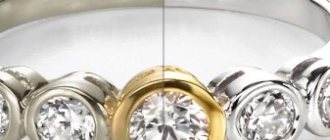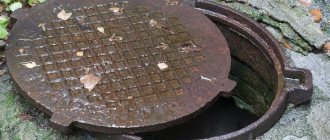History[edit | edit code]
The first nails were made from natural materials, such as fish bones and plant thorns, or hewn from hard wood.
The appearance of the first metal nails dates back to the Bronze Age, when they were cast or forged. Subsequently, wire - iron or copper - began to serve as the material for the production of nails. Thus, the Bible reports on the purchase of iron for nails by King David[1]. Bronze nails have been found during excavations of buildings in Ancient Egypt and other ancient cultures. Historical sources report the use of nails in the Roman Empire to nail criminals to wooden crosses [ source not specified 3732 days
]. In Russia, references to master nailers have been known since the 13th century[2].
Modern nails are made primarily of steel. In some cases, they are made of brass, copper, bronze, zinc, plastic and other materials.
Subscription
Category: Tool selection › Accessories Date: 2013-01-02 19:40:57 Almost everyone is familiar with such a simple tool as a hammer. It is well known that it is used to hammer nails. What could be simpler than a regular nail? However, a large selection of types of construction nails
allows you to choose the best option for solving various problems. The number of their types amounts to dozens, let's take a detailed look at just some of their types.
It is preferable to use nails not with those that came to hand first, but with the most suitable ones. This will ensure durability and reliability of the fastening. Nails in construction supermarkets are presented in a huge assortment; when choosing them, it is important to focus on the features of their design and the material for which they will be used. With the help of some types, simple wooden boards are fixed, while others are intended for fastening to the reinforced concrete base of structures. Using nails, plank floors are secured, baseboards are fixed, windows and door frames are installed, and wooden stairs are made. The operation of these fasteners is accompanied by significant loads.
Modern types of nails
Iron or steel wire is used to create simple construction nails. Raw materials must undergo heat treatment. To make the marking, a couple of numbers are applied: the diameter of the nail shaft and the length of the hardware. The head of construction nails can be smooth or may have corrugations. The rods of some types of products have a notch, the presence of which increases the strength of the connection. Nails of this type have become particularly widespread, they are affordable and allow you to connect products from various wood species.
Nails may have a special purpose. This series includes hardware with a long head in the shape of the letter “L”, square products or components with a double head. Square hardware is used to create hooks; thanks to the presence of a special notch, they are reliably protected from turning in a wooden block. With their help, you can attach to the base of any part without punching a hole in it. This became possible due to the special design of the hardware head. In products with a double cap, special convenience is achieved when creating and disassembling formwork. They are easily driven in and removed using a nail puller. If necessary, they can be reused.
Decorative nails are presented in a wide range. They are distinguished by an aesthetically pleasing and wide cap, which gracefully presses leatherette door upholstery or wall drapery. The cost of this type of hardware is higher than construction nails,
they are sold individually. Such products are made from black metal; in some cases, stainless or acid-resistant steel is used for this. Their coating has a protective or aesthetic role. To give nails an external appeal, copper, nickel or chromium are used for their production, as a result of which the components become especially beautiful. Chrome or zinc coating will provide reliable protection against corrosion.
Features of duckert nails and screw hardware
For flexible and bendable materials, hot-dip galvanized screw nails are used. They perfectly withstand increased humidity and loads. They are used to perform external upholstery of buildings, as well as in the manufacture of floors and piers. Screw nails sometimes use a countersunk head. They allow you to increase the strength of the connection four times more than when using other types of construction nails.
Nails with a very small head are called duckert nails. They are used to secure slabs, lining, and casing of doors and windows if you need to hide the hardware from view. These nails are simply covered with putty, after which they are covered with a layer of paint. Thanks to the recesses that are present in the head of the duckert, the task of finishing off the nail is simplified. The base of the cap is uneven, so it is securely attached to the putty.
Characteristics of comb nails and dowel nails
Dowel-nails are made from steel grades 70, VK or KK, processed at high temperatures. Their washers are made from cold-rolled metal strip, carefully adhering to GOST standards. Further, the products do not undergo heat treatment.
If you need to get a particularly strong fastening, comb nails are used when working with interior trim and window slopes. They are equipped with a transverse notch, which increases the fastening strength five times compared to classic nails. Hardened comb nails are used for working with high hardness material.
Construction nails
The most common and versatile type of nail. It has a smooth body and a cap that can be straight or cone-shaped. The diameter of the head is 3-4 times larger than the rod. Small notches are made on the working body near the head - this improves the holding capacity and at the same time does not interfere with driving in and, if necessary, removing fasteners. Construction nails are made both without coating and with protection, in the form of a thin layer of zinc.
Main purpose
As the most versatile type of fastener, construction nails are used in the construction of any wooden structures. They are used for fastening wooden parts to each other, mounting hinged elements to wooden surfaces, fastening solid sheet materials, in particular OSB, MFP, etc. The main advantage of construction nails over other hardware is their low cost, high fracture strength, ease of dismantling and the widest dimensional net*.
Length:
16, 20, 25, 32, 40, 50, 60, 70, 80, 90, 100, 120, 150, 200, 250, 260, 300, 310 mm
Diameter:
1.2, 1.4, 1.6, 1.8, 2.0, 2.5, 3.0, 3.5, 4.0, 5.0, 6.0, 7.6, 8.0 and 8.8 mm
As you can see, the gradation of diameters is narrower, so nails of different lengths can have the same thickness.
*GOST 4028-63
Nails for metal and concrete
Of all the nails on the market, the ones that stand out are those designed for working on metal, brick and concrete.
Regular nails work great on wood, but they cannot be driven into a brick wall or metal without first drilling, which, of course, increases the amount of work. Fortunately for us, fast direct installation technologies using pneumatic, gas and powder tools are now widespread. They have high power, which allows you to reliably fasten solid materials without prior preparation. Powder tools stand apart in this line, as they require a special license to purchase and use. Pneumatic and gas tools can be purchased and used freely. For them, there are several different types of fasteners, which, on the one hand, perform similar functions, but on the other, still have differences.
Below we will look at which type of nail is best suited for different jobs, as well as some features of their use. For convenience, we have arranged the nails in the list below in order of increasing cross-section of the working body of the nail. We also immediately note that for each type of nail, based on their standard size, a different tool is used, pneumatic or gas. Unfortunately, there is no universal tool that can be used with several types of nails, so before purchasing you need to clearly understand what kind of work you are using this or that fastener for.
Nail FST
• Nail cross-section: 1.8 mm • Nail length: 18-50 mm • Head cross-section: 3.2 x 1.8 mm
Nail type FST (also called FST pin) is designed for mounting wooden elements to metal and concrete. The thickness of the wood in this case does not play a big role, since the nailer easily penetrates through it, but the following requirements are imposed on the metal: the thickness of steel is no more than 2 mm, aluminum - no more than 2.5 mm. As for concrete, the nail can be driven into concrete grade 300 and below without any problems. Due to the small head (the smallest of the presented types of fasteners), this nail can be used to install solid finishing materials with little noticeability of the fastener itself.
Application:
- Installation of plywood and other wood panels to metal frames and concrete;
- Production of furniture on a metal frame;
- Finishing work with fastening materials to metal and concrete.
Nail T-ST
Nail cross-section: 2.2 mm Nail length: 18 – 75 mm Head cross-section: 6.9 x 2.2 mm
Nail type T, also known as type ST, has a larger cross-section of both the head and the working body of the nail, compared with the previous nail. Due to this, it can pierce metal up to 3 mm thick and concrete up to 400 grade. In addition, due to its larger head, it provides greater holding power for less dense material. The downside is the visibility of such fasteners, which limits its use in finishing. This nail is also intended for mounting wooden and materials of similar density to metal, brick and concrete, but at the same time, it can also be used for fastening sheet iron.
Application:
- Assembling furniture on a metal frame, adjusting the snake spring fastening.
- Installation of plywood to the screed
- Fastening wood boards to metal and concrete
- Installation of metal guides in concrete and brick, installation of sheet iron.
Nail CP
• Nail cross-section: 2.6 - 3.1 mm.
• Nail length: 15 – 65 mm. • Head section: 6.0 - 6.7 mm Nail type CP, also known as dowel-nail, is the largest of all nails presented, both in terms of the diameter of the working fluid and the diameter of the head. Depending on the diameter of the working fluid of the nail, ordinary and reinforced CP nails are distinguished, the main difference of which is the ability to work with harder grades of concrete and greater thickness of metal.
A distinctive feature of the nail is the plastic cassette in which the nail is supplied. FST and T nails are supplied in the form of a cassette, glued together using a special adhesive tape, which is included in the material along with the fasteners. In the case of the CP nail, the remainder of the plastic cassette remains visible at the fastening site, which, on the one hand, increases the fastening area, and on the other hand, does not look aesthetically pleasing, which limits the use of this nail in finishing.
But if we are talking about construction work, then this nail can fasten almost any materials: wood, metal, brick, concrete. It is worth noting that the main and most popular tool for working with this nail are gas nailers, which operate on the energy of liquefied gas. They transmit power up to 100 joules to the nail, which allows you to work with the hardest materials without pre-drilling. You can nail wooden and metal products with a thickness (metal up to 3 mm)
Application:
- Installation of wood boards to metal, brick, concrete screeds;
- Installation of reinforcing and plaster mesh
- Installation of wooden and metal guides
- Electric installation work
- General construction installation work
The history of the Sadhu board.
40 years ago, the Indian ascetic Amar Bharati raised his hand up in the name of happiness and peace on Earth and has not lowered it until now. He was very worried about the many evils and violence happening on the planet, and had compassion for all living beings. Therefore, I decided to abandon selfishness and devote my life to spiritual service.
This practice of voluntary asceticism is not uncommon in India and has existed for many thousands of years.
The word “sadhu” in India refers to ascetics who have withdrawn from the world and devoted their lives to directed spiritual practice. Often sadhus choose one practice “sadhana” and follow it for the rest of their lives.
For example, someone might choose to stand on one leg for 40 years as a sadhana, while another sadhu might vow not to cut his nails or remain silent for the rest of his life. Thus, sadhus directed all their will towards one specific intention and dedicated it to the happiness of all living beings.
Today we do something similar, but in a much more condensed form, when we stand on a board with nails. Standing on the board for at least 15 minutes requires a strong and pure intention. We can devote this intention to the fulfillment of some of our desires, and then a huge release of energy will direct our mental processes towards its implementation, sweeping away all blocks, doubts and laziness along the way.
We can also dedicate this mini-penance of standing on nails to higher intentions, such as world peace or the happiness of all beings on earth. Then it will be a real spiritual practice.
But even without the spiritual component, standing on nails has a strong healing effect on the entire body. This is why nailing has been gaining popularity in recent years.
Equipment for the production of nails
The following equipment is used:
- Nail machine . Pay attention to the length and width of the product it can produce. Universal machines will be more expensive than mini-devices designed to produce nails with a small diameter. The cost starts from 500 thousand rubles;
- Grinder . It will give the product a marketable appearance. The price of such a device is at least 200 thousand rubles;
- Packing machine . Packing nails by hand is difficult and time-consuming. But, you can purchase a packaging machine that will be used to pack goods in an automated manner. Its price is approximately 400 thousand rubles;
- Tap . His task is to lift coils of wire and install them into the machine. Price – 150 thousand rubles.
The above prices are for new equipment. You can save money and purchase used machines. But you should do this carefully, making sure that the products are in good working order and have not completely exhausted their service life. The equipment must be repairable, and spare parts for it must be available for free sale.
Production technology[edit | edit code]
By the end of the 19th century, forged nails were the subject of an extensive cottage industry. Production, as a rule, consisted of the following: a worker took an iron rod, heated it in a forge, and with hammer blows pulled it back on an anvil, sharpening it at the end and leaving a thickening in place of the future head. Then the rod at the head was cut off and inserted into a block with a hole (nail), after which the nail head was flattened with a hammer. Master nailers achieved considerable speed in making nails, managing to forge two nails while the rod was cooling, and a certain James Leiston in Birmingham forged 17 thousand nails in two weeks.
In other cases, the nails were cut from an iron strip (crutches). The technology involved cutting such a strip first into transverse strips with a width equal to the expected length of the crutch, and then lengthwise into separate pieces (diagonally so that one end was pointed) to obtain longitudinal fibers in the crutches themselves. Then the blunt side was bent in the nail maker to form a head. Crutches, with their narrow heads, are used in carpentry.[3]
The same operations subsequently began to be performed by machines. Nails were forged from hot iron and from cold iron. Cast nails were made from cast iron and annealed.
Modern nailing production typically uses rotary presses; Most stages of the manufacturing process, right down to deburring and anti-corrosion coating, are automated. In the 1980s, the length of factory-made nails varied from 6 to 250 millimeters, and the thickness from 0.8 to 8 millimeters[2].
How are nails made?
How did ancient people make nails? The first nails were invented back in primitive times; they were made from hard wood, fastening together the wooden parts of a home or other buildings. Nails were also made from other natural materials, using fish bones or sharp plant thorns. In the Borovichi district there is a nail museum, where you can see nails from different times, ranging from wooden ones, of different sizes and brands.
By the way, wooden nails have never lost their relevance. At the beginning of the 20th century, village shoemakers skillfully hammered miniature birch nails into the soles of their boots. The birch stilettos swelled from the water and held the soles tightly.
The answer to the question of when and from what metal nails were made in the old days suggests itself. The first metal nails began to be made in the Bronze Age, casting or forging them from copper and bronze, and subsequently, in the Iron Age, from a more durable material - iron.
Antique nail
Depending on their purpose, the nails had their own names. For example, “baroque nails” were used for the construction of river vessels, and “ship nails” for sea shipbuilding.
In the 19th century in Europe, the production of nails in factories was carried out manually in a handicraft way (small-scale production using manual labor): blacksmiths brought a metal rod to a heat in a forge, stretched it on an anvil and sharpened it at the end. After this, the workpiece at the head was cut off and flattened in a block with a hole with a hammer to give the shape of the head.
Nails only became a common commodity in the first decades of the 19th century with the invention of forged and wire nailing machines. Wikipedia states that the patent for the nailing machine was received in 1790. However, in the dictionary of Brockhaus and Efron we will see a different date: “The patent for the first machine for making nails was received in England in 1606 by Sir Davis Bulmer,” while it is noted that this invention had no effect on practice.
What and how are nails made nowadays?
Today they are made mainly of steel. For special purposes, nails are made from copper, brass, bronze, zinc and other materials. There are examples of the use of more unusual materials. Germany produces steel nails with a thin polymer coating. Their use is justified in the furniture business; thanks to the protective coating, rust does not damage expensive wooden products. Fiberglass safety nails are as strong as iron fasteners. They are also used for fastening furniture parts, in shipbuilding, etc. Plastic nails are produced in Japan. They are very durable and can be easily driven even into oak boards.
In modern nail production, rotary presses are mainly used. Products - products with a length from 6 to 400 millimeters and a thickness from 0.8 to 8.8 millimeters. To make nails, wire with a round cross-section is used as semi-finished products.
The working mechanism of a nail machine consists of a simple algorithm: the device cuts a nail to the required length, forms a head and forms a pointed end.
The video shows the process of making nails on a machine.
izobreteniya.net
Registration procedure
The first step is to register your activity. To do this, there is no need to organize a legal entity; it is enough to simply register as an individual entrepreneur. The best option would be to choose a simplified taxation system, which will allow you to pay only 15% of the profit received to the treasury.
If you plan to make nails at home, you will not need to look for a room. If the future enterprise is organized as a small business, then it will be necessary to search for a suitable place to open a mini-workshop.
Nails for nailers[edit | edit code]
With the advent of nail guns (nailers), a new format of nails appeared - in a cassette. Several dozen construction nails were assembled together on paper or plastic tape using a machine. For ease of operation, such cassettes are made at an angle of 21 or 34°. This has resulted in some nail cassettes having a cut-off (D-shaped) head.
Nails with a small cross-section for finishing work are glued into cassettes on special machines using glue or tape. In this production, the wire for nails is first collected into a cassette and then cut into plates of the required length.
Design and operation of a rotary nail production machine
The semi-finished product, wire, continuously enters the rotary apparatus through straightening rollers 1 at a speed corresponding to the operation of the friction feed rollers 2.
From the friction rollers 2, the wire passes into the cutting heads 3, in which the wire is cut into separate sharp pieces by rotating knives.
Under the force of the knives, the workpieces enter the wiring 4, at the exit of which they are captured by the clamping drum.
Wiring 4, which is an auxiliary transport element, can be eliminated if the clamping drum itself grabs the workpiece directly from the cutting heads 3.
Diagram of a rotary nailing machine.
The front part of the clamping drum 5 is a ring on which fixed matrices 11 b are located.
The rear part of the clamping drum 5 constitutes a system of sliders 6, which can move in grooves along the axis of this drum.
The sliders 6 are equipped with end rollers that roll around the profile ring 7, mounted on the machine body.
Movable matrices 11a, mounted on sliders 6, approach and diverge from fixed matrices 11b. This ensures that the workpiece is captured and clamped and the finished nail is ejected by the matrices. The axis of the fork 8 passes through the slider 6 and is strictly coordinated with the axes of the movable and stationary dies, so the workpiece removed from the wiring 4 by the fork 8 is directly clamped by the dies without additional feed.
In order to better center the workpiece and eliminate possible rotations during gripping, a trigger 9 is mounted on the fork 8, controlled by a sear 10. The sear is located on a hinge in the top cover of the slider 6.
The quick-release trigger 9 slams the grip fork 8 after the workpiece is removed from the wiring.
The moment of locking the workpiece by trigger 9 is regulated by sear 10.
When the slider 6 moves towards the profile ring 7, the matrices 11a and 11b open, and the grip 8 moves back along with the trigger 9. In this case, the trigger, resting its end against the plane of the sear 10, opens, overcoming the force of the spring holding it, and releases the finished nail. After the gripper has removed the new workpiece from the wiring and carried it to the punches for landing the head, the sear 10 passes by the stationary bracket and turns on a hinge.
With further movement of the slider 6, the trigger 9 also moves forward, which, catching on the plane of the sear 10, is cocked again to clamp the next workpiece.
The nail blank obtained in the cutting heads 3, facing the sharp end forward, enters the wiring 4, the workpiece is removed from the wiring by a fork grip 8, after which the sear 10 turns and releases the trigger 9, which locks the workpiece in the grip 8.
In the process of further movement, the workpiece lying in the gripper is gradually clamped by the shifting matrices 11a and 11b. The final clamping of the workpiece occurs before it meets the punch, when the profile ring 7 presses the slider 6 with its matrix 11a to the stationary matrix 11b.
The punch 12, inclined towards the clamped workpiece, first hooks with its side edge onto the stop 15, and sliding along this stop, comes into frontal contact with the end of the workpiece and dislodges the head of the nail. In this case, the punch simultaneously rotates around the swing axis 13, stretching the spring 14.
Upsetting ends when the axes of the workpiece and punch 12 are in line with the centers of rotation of the clamping drum and upsetting disk. The punch 12 then, due to radial movement, moves away from the manufactured nail, slides off the stop 15 and, under the action of the spring 14, returns to its original position.
Having passed the line of the centers of the machine, the slider 6 begins to move back, towards the profile ring 7, which controls its movement.
The movable matrix 11a moves away from the fixed matrix 11b, releasing the workpiece. At the same time, the trigger 9 also moves back, which, resting its end against the plane of the released sear 10, opens and allows the fork grip 8 to throw out the finished nail, which falls into the receiving tray 16.
Having freed itself from the nail, the fork 8, with the trigger 9 open, approaches the wiring 4 and accepts the next workpiece. Then the entire cycle of movement of the machine is repeated.
There are 6 tools on each machine disc. Therefore, in one revolution the machine performs technological operations for producing 6 nails.
The kinematic diagram of the machine is very simple. The shafts of all disks are located parallel and have a rigid connection with the gear cage. In this case, the gears are located in an oil bath, in the rear part of the machine body.
The gear system has a gear ratio of one, so all tools operate at the same speed.
Waste from nail production
Back to top
During the manufacturing process of nails, metal waste is generated.
At the end of the wire, rolled into a bundle or wound on a spool, there are notches from the grip of the drawing drum by the pliers. When threading wire into a nailing machine, this damaged end must be cut off in order for the wire to pass through the wiring and clamping dies. The weight of the cut piece of wire depends on the diameter, length of the damaged part and the type of nailing equipment.
After unwinding the coil or coil, there are also pieces of wire left that cannot be used in the nailing machine and go to waste, the amount of which is determined by the number of coils or coils required to produce one ton of nails, and the length of the segments, depending on the type of machine for producing nails.
Geometric shape of the nail tip.
After making 1 ton of nails, the result is from 30 to 100 kg. waste, depending on the size of the nail.
In the process of setting up a nailing machine, defective nails are formed, which is adjustment waste - 12 pieces of nails per setup.
During tumbling (polishing), the trim breaks off from the tips of the nails, and burrs from the heads, which also form waste.
According to GOST 283 - 48, the pointed part of the nail can have a round or square cross-section. Typically, the tip of the nail has the shape of a tetrahedral pyramid with horseshoe-shaped cuts above the base.
In the technological process of making nails, the end of the nail is bitten off with trimming knives (nippers) to form a pointed part. In this case, metal waste (“pieces”) is formed. The loss of metal can be calculated based on the data in the table; the specific numbers are very dependent on the type of nail production machine and its settings. Therefore, the data is indicative in nature.
Approximate weight of waste from nail production
| Nail size, mm | Weight of metal waste per 1 ton of nails, kg | Nail size, mm | Weight of metal waste per 1 ton of nails, kg | Nail size, mm | Weight of metal waste per 1 ton of nails, kg |
| 0,7×7 | 96,9 | 0,8×9 | 86,9 | 0,9×12 | 74,0 |
| 1,0×15 | 66,2 | 1,2×20 | 59,9 | 1,2×25 | 48,3 |
| 1,4×20 | 69,3 | 1,4×25 | 56,0 | 1,4×30 | 47,0 |
| 1,4×25 | 31,7 | 1,6×25 | 63,7 | 1,6×30 | 53,5 |
| 1,6×35 | 46,1 | 1,8×30 | 61,6 | 1,8×35 | 52,9 |
| 1,8×40 | 46,4 | 2,0×40 | 51,4 | 2,0×45 | 40,8 |
| 2,2×45 | 50,4 | 2,2×50 | 45,4 | 2,5×50 | 51,44 |
| 1,5×60 | 43,0 | 3,0×70 | 44,2 | 3,0×80 | 38,7 |
| 3,5×80 | 45,1 | 3,5×90 | 40,1 | 4,0×100 | 41,7 |
| 4,0×110 | 37,9 | 4,5×45 | 37,5 | 5,0×150 | 34,7 |
| 5,5×175 | 32,7 | 6,0×200 | 31,2 | ||
| Tar paper nails | |||||
| 2,0×20 | 101,56 | 2,0×25 | 81,68 | 2,2×25 | 88,60 |
| 2,2×30 | 77,32 | 2,5×30 | 85,03 | 2,5×35 | 73,08 |
| Roofing nails | |||||
| 3,5×45 | 77,47 | 4,0×50 | 70,04 | ||
what are nails made of
Kozhemyakovy, related to rawhide processing. Carpet beetle m. skin moth, insect Dermestes. Leather-eater, eating skin. Skin mushroom scientist. leathery fungus Dermodium growing on stumps. Kozhesemyannik scientist. flowerless plant Dermosporium. Skin-bearing mushrooms, scientist. fundi dermatocapri. Leathergill slugs, scientist. Dermobranchia. Leather-toothed fish, or rather toothless
• get out of it
• what they are trying to get out of
• Vasilisa’s frog changeable “clothes”
• novel by the French writer Honore de Balzac “Shagreen ...”
• what does the German word “leder” mean, from which the name of the binding material lederin comes from?
• what is raw meat
• what is suede
• that Apollo tore Marsyas off the shepherd as punishment for winning a competition
• “derma” translated from Greek
• “shagreen” by Balzac
• What is yuft
• Vasilisa’s frog changeable “clothes”
• what is yuft?
Perhaps everyone knows what construction nails are. They are very widespread and have even entered folklore: “Bored like a nail in a shoe”, “Stuck like a nail” - these are just the most common sayings about these fasteners.
Structurally, a modern construction nail is a fairly simple product, and it consists of such elements as a cap (head) and a pointed rod.
How to hammer in and remove construction nails correctly?
Many people think that hammering nails is very simple, but in fact this process has its own nuances and subtleties. Therefore, in order not to injure your fingers and not bend these fasteners when driving, you should definitely know them.
It should be noted that there are very few rules for fastening nails, and compliance with them is not particularly difficult.
The first of them is that after a small nail is placed with its tip at the place where it will be hammered, it is necessary to press the head with some force.
This will allow you to “bait” it and then no longer hold it with your fingers while hammering in with the risk of damaging them.
If you need to drive a large nail, then it should be held strictly perpendicular to the surface to be fixed, and in close proximity to it.
Another important rule that should be observed when driving nails is that if they begin to bend during this process, there is no need to try to “drive” them further. You need to pull them out using pliers or a nail puller, carefully align them on the anvil with a hammer and try to drive them back in.
If the nail does not go in, then this most likely means that the material is too hard for it, and therefore it makes sense to do the following: or drill a hole for it with a diameter of about a third of the diameter of the rod (that is, proceed approximately in the same way as when driving self-tapping screws), or use a nail made of a more durable material.
When fastening parts with nails, one more important rule must be observed. It consists in the fact that this fastening element must extend into the lower part by at least two-thirds of the length of the rod.
Areas of application and types of nails
At first glance, it seems that nails have lost their relevance and have been replaced by more durable fastening materials. But in fact, no builder can do without nails; they are simply necessary in many cases.
Anchor
Such nails are intended for durable and strong connection of parts. Anchor nails are used for wall cabinets, heavy and large paintings, furniture assembly, and construction work. There are many varieties of anchor nails; they have a wide range of applications. They differ in strength, size, and material of manufacture.
Screw
Screw nails are strong and are 4 times stronger than regular nails. They are made from hot-dip galvanization and are used for bending or flexible structures that are subject to moisture or heavy loads. They are used for floor structures, upholstery of buildings, fastening of heavy metal structures and moorings.
Rough flat head for Euro pallets
You cannot do without brush nails when laying wooden strips, floors, furniture assembly and other work. These nails secure wooden parts especially firmly and serve for many years without any complaints.
Square with L-shaped head
The L-shaped nail bracket is designed for working with wood, plaster, pressed cardboard and concrete. It fixes the products very firmly, and it is also convenient for them to work when it is necessary to hang something or secure hanging parts, but here you need to have experience and skill.
Construction
Ordinary nails are used for different types of work; if a construction nail is galvanized, it is used for external work; non-galvanized nails are most often used indoors.
There are many types of construction nails:
- hot galvanized;
- acid-resistant;
- copper nails;
- black not galvanized;
- electro-galvanized, etc.
All construction nails come in different shapes and sizes.
Finishing
Nails with a name that speaks for itself are used for final finishing of a room. Finishing nails come in different colors, sizes and are almost invisible to the eye on the surface. This includes upholstery, doorways, installation of plastic in the bathroom and other little things.
Slate with enlarged flat head
These nails are intended for working with roofing materials, initially with slate, but are excellently used for wooden fastenings. They fit into the material reliably and without creating cracks, while being tightly fixed.
For bitumen coatings
Such nails are used for bituminous materials, windproof boards, construction cardboard, etc. Thanks to the large nail head, it holds well in porous materials. The surface does not break, and the fastening is reliable.
For drywall
These nails are used for fastening fragile materials. These can be plasterboards, fiberboards, construction cardboard, thin boards of wood, etc. Drywall nails are used very often today, because this building material is in demand for various finishes.
Double cap
A nail with a double head is used for structures that are collapsible. These can be greenhouses, hotbeds, thick films that need to be attached to the part, etc. Such nails perfectly fix the material and do not spoil it, and then you can pull it out without any special effort, the structure will remain unchanged.
Comb nail
Such a nail is used if it is necessary to fix the parts especially firmly. The ridge nail is perfect for window trim and interior trim. Thanks to the transverse notch, the fastener is 5 times stronger than a regular nail. The comb nail is available in two versions: regular and for hard materials (hardened).
Duckert nail
This nail has a barely noticeable head, which is not visible when fastening cash, lining, slabs, baseboards and other materials. Finishing with Durect nails is convenient, quick and beautiful. And if the surface is painted, then you won’t notice it at all. It is easy and simple to apply putty on such nails, which will not fly off compared to ordinary nails; it’s all about the head, it has indentations and a rough surface.
Hardened steel nail
Such nails are used when working with concrete and brick, and, if necessary, attaching wooden products. They are firmly and reliably fixed inside concrete or brick, and press the wood tightly.
Staples
Use staples to firmly grip and fasten wires, metal mesh and barbed wire. The staples tightly clamp the metal and do not allow it to move, which makes the work of the master especially easier.
Liquid nail
Many people think that this is an easy to bend nail, but this is far from the case. This is not a nail in the usual sense, but a glue composition that is so dense that it can replace nails. You've probably heard the phrase glue instead of nails. This is it; you can reliably attach a mirror, plastic and other necessary decorative elements with its help.
Organizational structure
| Tariff rate (salary) per month, rub. | Allowances, rub | Monthly wage fund per unit, rub. | Monthly wage fund for all units, rub. | Deductions | Total for social contributions | |||
| Regional coefficient | Northern surcharge | Personal income tax | Contributions for social needs (34%) | Injuries (1.5%) | ||||
| 27000 | 8100 | 8100 | 43200 | 43200 | 5616 | 14688 | 648 | 20952 |
| 15000 | 4500 | 4500 | 24000 | 24000 | 3120 | 8160 | 360 | |
| 12000 | 3600 | 3600 | 19200 | 19200 | 2496 | 6528 | 288 | |
| 6250 | 1875 | 1875 | 10000 | 20000 | 2600 | 6800 | 300 | 9700 |
| 6250 | 1875 | 1875 | 10000 | 20000 | 2600 | 6800 | 300 | |
| 2900 | 870 | 870 | 4640 | 4640 | 603,2 | 1577,6 | 69,6 | 2250,4 |
| 2900 | 870 | 870 | 4640 | 4640 | 603,2 | 1577,6 | 69,6 | |
| 36150 | 10845 | 10845 | 57840 | 67840 | 8819,2 | 23065,6 | 1017,6 | 32902,4 |
( 1 rating, average 5 out of 5 )
Construction staples
Formally, these are no longer nails, but such fasteners are often indispensable when working with wood. By the way, small staples are often called mesh nails. The staples have a thickness of 6 to 16 mm, but the most popular standard is 8 and 10 mm. The product size designation includes three numbers: diameter, back and leg length.
Main purpose
Fastening logs and beams in wooden house construction. Fastening the floor and ceiling joists. Strengthening the connections of a frame house. Fixing the corner logs of the crown with each other. In general, forged staples are indispensable for the reliable connection of any large-sized lumber, not only logs and beams, but also thick boards.
Popular sizes
: 8x200x70, 8x250x70, 8x270x70, 10x200x70, 10x250x70, 10x270x70 mm.
This material is also available on our website:
https://woodschool.ru/kakie-byvayut-gvozdi.html
Construction nails manufactured according to drawing 7811-7075
This is another document regulating the production of construction nails. Its Western European analogue is the German standard DIN 1151. Both standards establish one version of fasteners of this type.
A distinctive feature of such nails is the presence of grooved knurling on the outer surface of the head. This reduces the likelihood of the working part of the hammer slipping off the head of the hardware when driving it.
The numerical values of the technical characteristics of construction nails manufactured according to drawing 7811-7075 vary in the following ranges:
- stem diameter (designation d) – from 1.2 mm to 9.4 mm:
- cap diameter (parameter D) – min 2.6 mm; max 20.7 mm;
- cap height – minimum 0.5 mm; maximum 2.3 mm;
- nail length (designation L) – from 15.0 mm to 310.0 mm.
